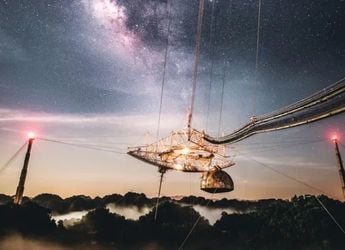- Home
- Science
- Science News
- Elon Musk's SpaceX to Make Second Bid to Launch Starship Rocket on Test Flight
Elon Musk's SpaceX to Make Second Bid to Launch Starship Rocket on Test Flight
A planned liftoff Monday of the gigantic rocket was aborted less than 10 minutes ahead of the scheduled launch.
Photo Credit: Reuters
Starship is both bigger and more powerful than SLS
SpaceX is to make a second attempt on Thursday to carry out the first test flight of Starship, the most powerful rocket ever built, designed to send astronauts to the Moon, Mars and beyond.
A planned liftoff Monday of the gigantic rocket was aborted less than 10 minutes ahead of the scheduled launch because of a pressurization issue in the first-stage booster.
The new window for liftoff from Starbase, the SpaceX spaceport in Boca Chica, Texas, opens on Thursday at 8:28 am Central Time (1328 GMT) and lasts for about an hour, SpaceX said.
SpaceX founder Elon Musk, who has sought to play down expectations for the risk-laden inaugural test flight, cast some doubt on whether the launch will actually go ahead on Thursday.
"The team is working around the clock on many issues," Musk tweeted late Tuesday. "Maybe 4/20, maybe not."
The US space agency NASA has picked the Starship spacecraft to ferry astronauts to the Moon in late 2025 -- a mission known as Artemis III -- for the first time since the Apollo program ended in 1972.
Starship consists of a 164-foot (50-meter) tall spacecraft designed to carry crew and cargo that sits atop a 230-foot tall first-stage Super Heavy booster rocket.
SpaceX conducted a successful test-firing of the 33 massive Raptor engines on the first-stage booster in February but the Starship spacecraft and the Super Heavy rocket have never flown together.
The integrated test flight is intended to assess their performance in combination.
Monday's launch was scrubbed because of a frozen pressure valve on the Super Heavy booster and SpaceX needed to delay another try for 48 hours to recycle the liquid methane and liquid oxygen that fuels the rocket.
Musk had warned ahead of the launch that delays and technical issues were likely.
"It's a very risky flight," he said. "It's the first launch of a very complicated, gigantic rocket.
"There's a million ways this rocket could fail," Musk said. "We're going to be very careful and if we see anything that gives us concern, we'll postpone."
Multi-planet species
NASA will take astronauts to lunar orbit itself in November 2024 using its own heavy rocket called the Space Launch System (SLS), which has been in development for more than a decade.
Starship is both bigger and more powerful than SLS and capable of lifting a payload of more than 100 metric tonnes into orbit.
It generates 17 million pounds of thrust, more than twice that of the Saturn V rockets used to send Apollo astronauts to the Moon.
The plan for the integrated test flight is for the Super Heavy booster to separate from Starship about three minutes after launch and splash down in the Gulf of Mexico.
Starship, which has six engines of its own, will continue to an altitude of nearly 150 miles, completing a near-circle of the Earth before splashing down in the Pacific Ocean near Hawaii about 90 minutes after launch.
"If it gets to orbit, that's a massive success," Musk said.
"If we get far enough away from the launchpad before something goes wrong then I think I would consider that to be a success," he said. "Just don't blow up the launchpad."
SpaceX foresees eventually putting a Starship into orbit, and then refueling it with another Starship so it can continue on a journey to Mars or beyond.
Musk said the goal is to make Starship reusable and bring down the price to a few million dollars per flight.
"In the long run -- long run meaning, I don't know, two or three years -- we should achieve full and rapid reusability," he said.
The eventual objective is to establish bases on the Moon and Mars and put humans on the "path to being a multi-planet civilization," Musk said.
"We are at this brief moment in civilization where it is possible to become a multi-planet species," he said. "That's our goal. I think we've got a chance."
Catch the latest from the Consumer Electronics Show on Gadgets 360, at our CES 2026 hub.
Related Stories
- Samsung Galaxy Unpacked 2025
- ChatGPT
- Redmi Note 14 Pro+
- iPhone 16
- Apple Vision Pro
- Oneplus 12
- OnePlus Nord CE 3 Lite 5G
- iPhone 13
- Xiaomi 14 Pro
- Oppo Find N3
- Tecno Spark Go (2023)
- Realme V30
- Best Phones Under 25000
- Samsung Galaxy S24 Series
- Cryptocurrency
- iQoo 12
- Samsung Galaxy S24 Ultra
- Giottus
- Samsung Galaxy Z Flip 5
- Apple 'Scary Fast'
- Housefull 5
- GoPro Hero 12 Black Review
- Invincible Season 2
- JioGlass
- HD Ready TV
- Laptop Under 50000
- Smartwatch Under 10000
- Latest Mobile Phones
- Compare Phones
- Samsung Galaxy A07 5G
- Vivo Y500i
- OnePlus Turbo 6V
- OnePlus Turbo 6
- Itel Zeno 20 Max
- OPPO Reno 15 Pro Mini 5G
- Poco M8 Pro 5G
- Motorola Signature
- Lenovo Yoga Slim 7x (2025)
- Lenovo Yoga Slim 7a
- Realme Pad 3
- OPPO Pad Air 5
- Garmin Quatix 8 Pro
- NoiseFit Pro 6R
- Haier H5E Series
- Acerpure Nitro Z Series 100-inch QLED TV
- Asus ROG Ally
- Nintendo Switch Lite
- Haier 1.6 Ton 5 Star Inverter Split AC (HSU19G-MZAID5BN-INV)
- Haier 1.6 Ton 5 Star Inverter Split AC (HSU19G-MZAIM5BN-INV)

















